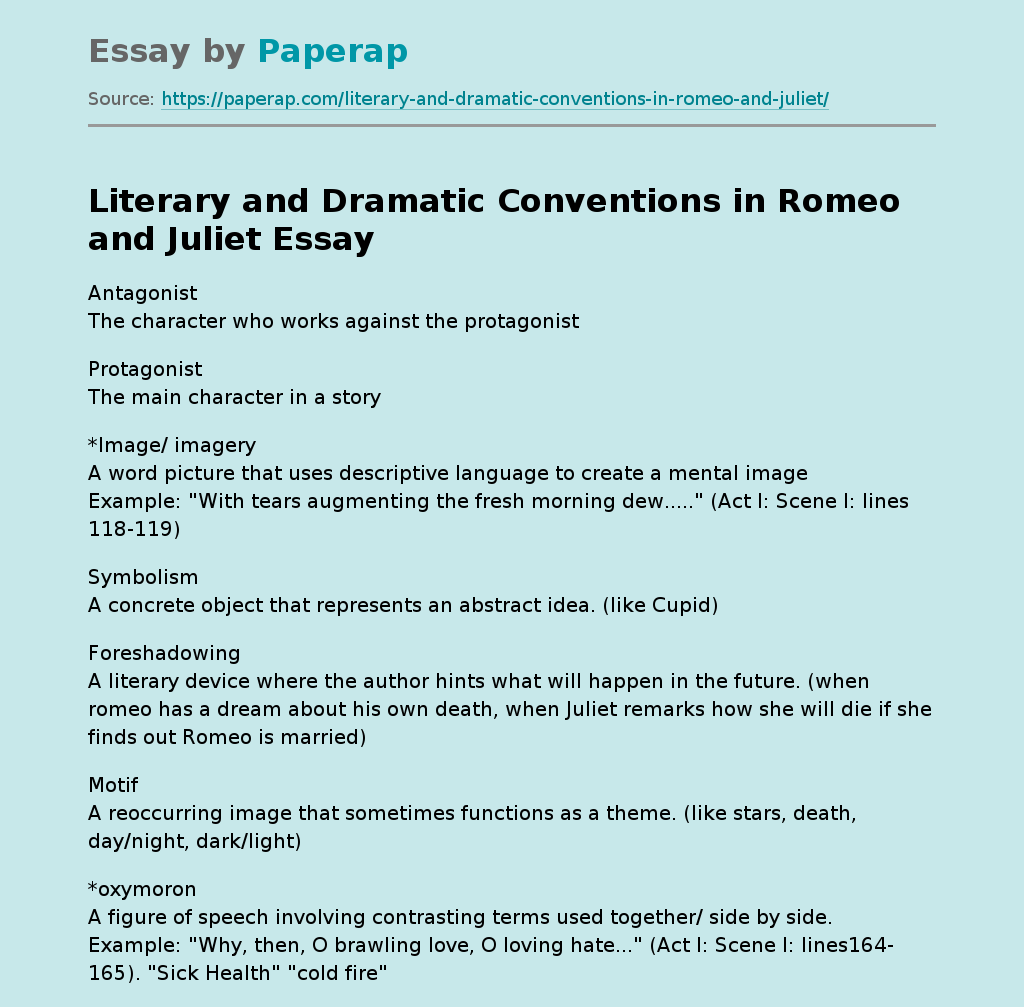Literary and Dramatic Conventions in Romeo and Juliet
Essay,
Pages 3 (657 words)
Views
640
Antagonist
The character who works against the protagonist
Protagonist
The main character in a story
*Image/ imagery
A word picture that uses descriptive language to create a mental image
Example: “With tears augmenting the fresh morning dew…..” (Act I: Scene I: lines 118-119)
Example: “With tears augmenting the fresh morning dew…..” (Act I: Scene I: lines 118-119)
Symbolism
A concrete object that represents an abstract idea. (like Cupid)
Foreshadowing
A literary device where the author hints what will happen in the future. (when romeo has a dream about his own death, when Juliet remarks how she will die if she finds out Romeo is married)
Motif
A reoccurring image that sometimes functions as a theme.
(like stars, death, day/night, dark/light)
*oxymoron
A figure of speech involving contrasting terms used together/ side by side.
Example: “Why, then, O brawling love, O loving hate…” (Act I: Scene I: lines164-165). “Sick Health” “cold fire”
Example: “Why, then, O brawling love, O loving hate…” (Act I: Scene I: lines164-165). “Sick Health” “cold fire”
*pun
A play on words that involves the sound and meaning of a word
Example: “We’ll measure then a measure….
Example: “We’ll measure then a measure….
” (Act I: Scene 4: lines 9-10)
*paradox
A statement where two opposite things seem to be true at the same time.
Example: “Alas, that love, so gentle in his view….” (Act I: Scene I: lines 157-158)
Example: “Alas, that love, so gentle in his view….” (Act I: Scene I: lines 157-158)
allusion
A figure of speech that references a famous person, place, event, or literary work- Reader is expected to know it. (like cupid, Reference to Aurora and Diana)
*blank verse
unrhymed lines of iambic pentameter
Example: “And pity ’tis….” (Act I: Scene 2: lines 5-6)
Example: “And pity ’tis….” (Act I: Scene 2: lines 5-6)
*iamb/ iambic foot
An iamb is a pattern or pair of syllables of unstressed and then a stressed syllable.
A foot is one of the [unstressed, stressed]
Example: “Not mad” “without” (Act I: Scene 2: lines 55-56)
*iambic pentameter
When each line has five iambs (10 syllables) of unstressed stressed syllables- sonnets use them
Example: “Enough of this; I pray thee, hold thy peace.” (Act 1: Scene 3: line 54)
Example: “Enough of this; I pray thee, hold thy peace.” (Act 1: Scene 3: line 54)
simile
A comparison using like, as, or seems.
Example: “Scaring the ladies like a crow-keeper” (Act 1, Scene 4, line 6)
Example: “Scaring the ladies like a crow-keeper” (Act 1, Scene 4, line 6)
Metaphor
A direct comparison without using like, as, or seems- (something IS something)
Example: “love is a smoke raised with the fumes of sighs;” (Act 1, Scene 1, 180)
Example: “love is a smoke raised with the fumes of sighs;” (Act 1, Scene 1, 180)
Personification
When an inanimate object is given human characteristics/traits
Example: “Now old desire doth in his deathbed lie” (Act 2 prologue)
Example: “Now old desire doth in his deathbed lie” (Act 2 prologue)
tragedy
a story with human conflict with an unhappy ending (usually death), especially one having to do with the main character
Subtext
The underlying meaning of a literary work- it is implied, never announced.
*prologue
an introduction that summarizes the who, what, when, and where of the story
Example: “Two households….” See front of book
Example: “Two households….” See front of book
soliloquy
A long speech where a character speaks their thoughts out loud (talks to themselves) when they are alone, or thinks they are along, on stage
Example: Friar Laurence’s Speech when he is collecting herbs in Act 2.
Example: Friar Laurence’s Speech when he is collecting herbs in Act 2.
monologue
A long speech given by a single actor in a play
example: Mercutio’s Lady Mab speech
example: Mercutio’s Lady Mab speech
*aside
when one actor says something to the other actor that the audience hears but not the others on stage
Example: “[aside to Gregory] Is the law on our side…” (Act I: Scene I: line 38)
Example: “[aside to Gregory] Is the law on our side…” (Act I: Scene I: line 38)
dramatic irony
Occurs when the audience knows more than the characters
Example: when Friar Laurence and Mercutio think that Romeo is still in love with Rosaline
Example: when Friar Laurence and Mercutio think that Romeo is still in love with Rosaline
verbal irony
Occurs when the speaker means something different that what is said
*enjambment
The continuation of one line in a verse to the next- when one line in the verse doesn’t have any end punctuation
Example: “That quench the fire of you pernicious rage With purple fountains….” (Act I: Scene I: lines 70-71)
Example: “That quench the fire of you pernicious rage With purple fountains….” (Act I: Scene I: lines 70-71)
Tragic flaw
In a tragedy, the flaw or character defect that brings the downfall of the protagonist
Tragic hero
The main character/protagonist in a tragedy
Comic Relief
When a humorous character or scene in a tragedy is included to relieve tension.
foil
a character who acts differently and contrasts another character in order to highlight specific traits and qualities in the other character.
Literary and Dramatic Conventions in Romeo and Juliet. (2019, Feb 04). Retrieved from https://paperap.com/literary-and-dramatic-conventions-in-romeo-and-juliet/

